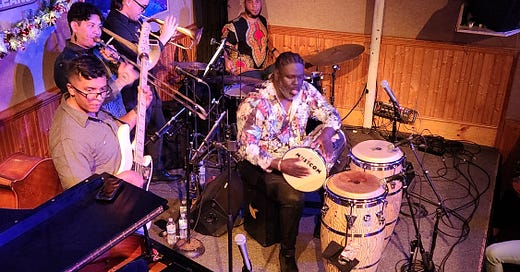The Lion in Louisiana
On Saturday, December 9th, Alexey Marti not only celebrated his birthday with an exceptional pair of shows at Snug Harbor, but he also put a triumphant exclamation point on 2023 and Cuban music in New Orleans. Local musicians and music lovers have his name, as well as Yusa, and Victor Campbell firmly in mind.
The emerging Cuban music scene here is not by accident. Back in 1999, Ariana Hall started the CubaNOLA Arts Collective to promote and explore the cultures of Cuba, as well as that of the Caribbean & Latin America. If you didn’t know, she also founded WWOZ’s “Takin’ it to the Streets” program with coverage of second line parades. Her steady focus put in place clear building blocks for what we see today.
As far as Marti himself, they say that eventual acclaim comes with longevity. As long as you maintain a high quality of whatever you do, your time will most likely eventually arrive. This is not to foolishly claim that what Marti has been building as a high-level conga player & percussionist since arriving here in 2008 was unnoticed. Not the shows, largely at Prime Example and Snug Harbor. Not his range, playing with New Orleans stalwarts like Herlin Riley & Wendell Brunious. And not his exceptional skills as a bandleader. All have made him a lion in Louisiana, and he’s on the verge of dropping a double-album.
But Alexey Marti has also found his day, because New Orleans has found its way. The city with strong Afro-Caribbean roots has rediscovered them. Restaurants like Charley Pierre’s Haitian spot Fritai and Lisa Nelson’s Trinabagonian Queen Trini Lisa are thriving. The Latin music scene, which for years was largely tucked away on the West Bank, now packs Saturn Bar, Rabbit Hole, Maison, or anywhere else with dancers. Marti himself is the newest member of the acclaimed New Orleans Jazz Orchestra.
In my Offbeat interview with internationally-heralded Yusa, she noted the New Orleans/Cuban synergy, “I feel comfortable in this place, because it's so familiar. This is the way I grew up. In Cuba. Music is all over, and we have music on the streets…We have so many connections…We grew up with the same kind of roots. This is kind of like an island, a small one...”
In the recent past, the term “tipping point” would have been used to describe what’s happening now. We’re seeing fresh rediscovery. What people call “New Orleans music” wouldn’t exist without what Jelly Roll Morton termed “the Spanish tinge,” over a century ago, which was essentially Cuban syncopation from the habanero beat. To take it further into general Latin influence, after Storyville, the infamous Basin St. red light district, was shut down in 1917, the night life shifted to the upriver part of the French Quarter.
The Tango Belt, roughly bordered by Rampart, Iberville, Dauphine, and St. Louis, was an area full of music clubs and dance halls. In the 1920s, it was the densest collection of clubs in the city. Tango bands traveled from Argentina and the Caribbean to play there. New Orleans groups included tango music in their repertoire. Eventually, the tango craze subsided and was replaced in the 1950s by rock & roll. Also key, gradually from the late 1930s to the 1950s, television replaced radio and live music as the dominant entertainment medium in the U.S. To quantify the impact, around 8,000 U.S. households had tv sets in the mid-1940s, but almost 46 million did by 1960, which was ¼ of the entire country. This had direct impact on live music attendance, even here.
The present shift is clear in New Orleans. It bears mentioning that Dance Quarter’s classes including Argentine Tango, Salsa, Bachata, and Zouk have been essential, as well as the growth of Bayou Movimiento dance company to build cultural interest and an increasing pool of dancers seeking live music.
Also important is to name Grammy-nominated rock-star Cimafunk, who has made New Orleans his second home base, and to attempt a rough list of the exceptional musicians who are also making this sound happen. They include Jafet Perez, Jose Colon, Ethan Santos, David Navarro, Cesar Bacaro, Victoria Douton, Katerin Llerena, Geovane Santos. Thinking more broadly of Afro-Caribbean & Latin music, I would be remiss not to mention Haitian group Ram, DJ C’est Funk, and the success of the inaugural Fiesta de Musica Nola this past March featuring Goez/Malaria, Los Guiros, Felipe K-Rrera, Conjunto Tierra Linda, Amigos Do Samba, and Cristina Kaminis.
Pianist-on-the-rise Victor Campbell said in his Offbeat feature, “My dream is to create something that people can say, ‘It's not New Orleans, it's not Cuban.’ It’s what we say in Cuba is ‘Caldosa.’ Put the different things together and create something…New Orleans and Cuba connect not only in the music. The way of the people is very similar.”




